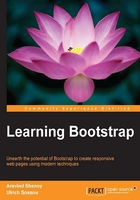
Conventions
In this book, you will find a number of text styles that distinguish between different kinds of information. Here are some examples of these styles and an explanation of their meaning.
Code words in text, database table names, folder names, filenames, file extensions, pathnames, dummy URLs, user input, and Twitter handles are shown as follows: "You will find that we have used the minified versions, that is, bootstrap.min.js and bootstrap.min.css, to lower the file size resulting in faster loading of the website."
A block of code is set as follows:
#packt {
padding: 19px 30px;
-webkit-border-radius: 35px;
-moz-border-radius: 35px;
border-radius: 35px;
color: red
}
When we wish to draw your attention to a particular part of a code block, the relevant lines or items are set in bold:
#packt {
padding: 19px 30px;
-webkit-border-radius: 35px;
-moz-border-radius: 35px;
border-radius: 35px;
color: red
}
Any command-line input or output is written as follows:
lessc --yui-compress bootstrap.less > bootstrap.min.css
New terms and important words are shown in bold. Words that you see on the screen, for example, in menus or dialog boxes, appear in the text like this: "Click on the Download Bootstrap button and the file will be downloaded in the ZIP format."
Note
Warnings or important notes appear in a box like this.
Tip
Tips and tricks appear like this.